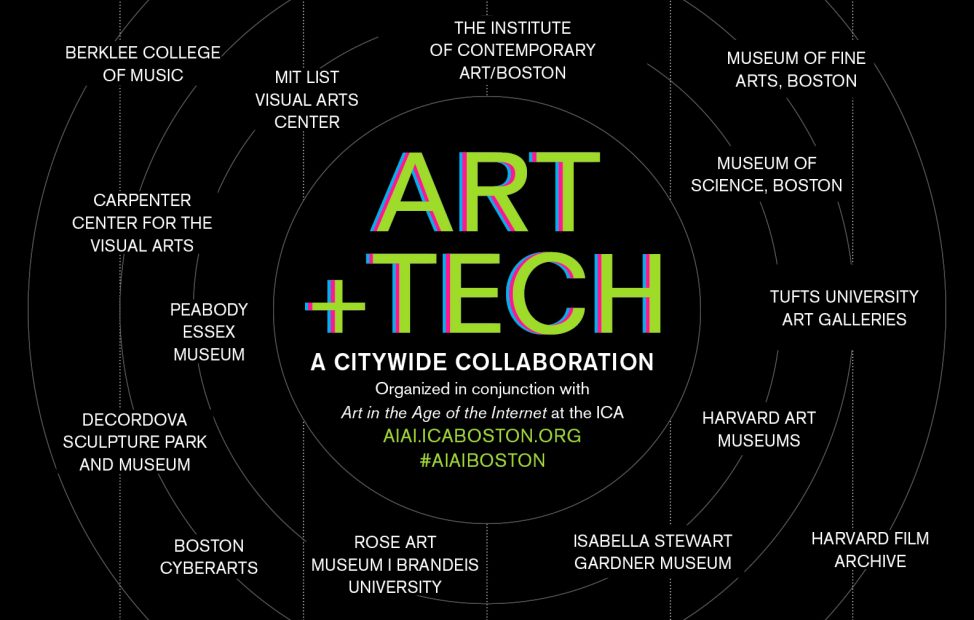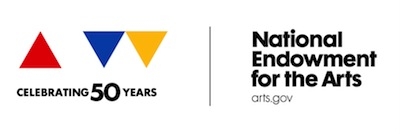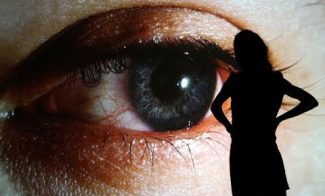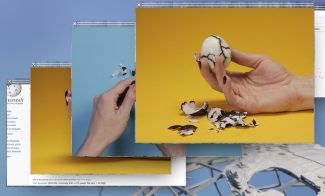
14 Boston-area arts organizations partner on ambitious, region-wide cultural collaboration dedicated to art and innovation, highlighting Boston as a center of technology
This winter, cultural organizations throughout Greater Boston are partnering to present an ambitious, region-wide exploration of art and technology, announced Jill Medvedow, Ellen Matilda Poss Director of the Institute of Contemporary Art/Boston (ICA). Aligned with the ICA’s sweeping exhibition Art in the Age of the Internet, 1989 to Today opening February 7, this extraordinary collaboration will offer the public concurrent exhibitions, performances, screenings, and programs at area cultural organizations, all exploring the relationship between art and technology. The organizations partnering with the ICA are:
- Berklee College of Music
- Boston Cyberarts
- Carpenter Center for the Visual Arts at Harvard University
- deCordova Sculpture Park and Museum
- Harvard Art Museums
- Harvard Film Archive
- Isabella Stewart Gardner Museum
- MIT List Visual Arts Center
- Museum of Fine Arts, Boston
- Museum of Science, Boston
- Peabody Essex Museum
- Rose Art Museum at Brandeis University
- Tufts University Art Galleries
“Art in the Age of Internet, 1989 to Today gives us the opportunity to examine all the forms of connectivity made possible by the internet, as well as to work in partnership with colleagues and institutions in Greater Boston,” said Medvedow. “The rich history of tech innovation in Boston makes this an ideal place to raise questions about community, privacy, networks, identity, surveillance and speed in a dynamic citywide experience.”
“The context of technological innovation in Greater Boston provides a crucial backdrop for the ICA exhibition and our collaboration—the first email was sent from Cambridge; the term ‘cloud’ was first coined in relation to the internet in an MIT research project; Facebook was invented here,” said Eva Respini, Barbara Lee Chief Curator and organizer of the ICA’s exhibition. “The exhibitions and programs presented by the partner institutions enrich the ICA’s exhibition by providing additional opportunities for audiences to connect with the topic of art and technology.”
aiai.icaboston.org
Audiences and scholars around the world can learn about Art in the Age of the Internet, 1989 to Today via a dedicated web platform. The extensive site will bring extended content and varying perspectives to the exhibition, and will virtually connect the activities of area partners.
PROJECT OVERVIEW
At the ICA
Art in the Age of the Internet, 1989 to Today explores the widespread cultural impact of the internet on art. Featuring a broad range of works across a variety of mediums—including painting, performance, photography, sculpture, video, and web-based works—the exhibition considers the extensive effects of the internet on artistic practice and contemporary culture. Themes explored in the exhibition include emergent ideas of the body and notions of human enhancement; the internet as a site of both surveillance and resistance; the circulation and control of images and information; possibilities for new subjectivities, communities, and virtual worlds; and new economies of visibility amplified by social media.
The exhibition features the work of 60 artists, collaborations, and collectives, including Cory Arcangel, Dara Birnbaum, Harun Farocki, Lizzie Fitch/Ryan Trecartin, Juliana Huxtable, Lynn Hershman Leeson, Trevor Paglen, Nam June Paik, Frances Stark, Cindy Sherman, Hito Steyerl, and Anicka Yi.
Exhibition-related programming includes an artist talk with award-winning artist Trevor Paglen in conversation with historian of science Jimena Canales, as well as a robust schedule of performances, organized by David Henry, Bill T. Jones Director of Performing and Media Arts, and John Andress, Curator of Performing Arts. These programs include Sounding the Cloud, a music performance by renowned composers Neil Leonard, Stephen Vitiello, and Scanner that explores what “the cloud” might sound like; Annie Dorsen’s The Great Outdoors, which is presented in an inflatable planetarium, inviting the audience to imagine the internet as a celestial place; and Ryan McNamara’s MEƎM 4 Boston: A Story Ballet About the Internet, an immersive, museum-wide experience that aims to recreate the feeling of surfing the web. For details about these programs, visit icaboston.org
Art in the Age of the Internet is organized by Eva Respini, Barbara Lee Chief Curator, and Jeffrey De Blois, Curatorial Associate. It is on view February 7 through May 20, 2018.
At Berklee College of Music
Berklee is sponsoring an interdisciplinary arts seminar designed to further expose music students to visual and performing arts. Students will visit the ICA exhibition, attend artist talks at the ICA, and hold regular off-campus meetings on-site at partner institutions. The seminar will culminate in “Binge Watch,” a public performance by Berklee students that explores the use of digital tools for musical expression, on Thursday, May 10 from 6:00 PM – 8:00 PM at the Museum of Fine Arts, Boston. Neil Leonard, Artistic Director of the Berklee Interdisciplinary Arts Institute, will lead the seminar.
At Boston Cyberarts
Artificial Creativity: Neural Network and Augmented Intelligence Art, explores new tools born of artificial intelligence research that artists are using to make unique new work. Neural network art is a tool for artistic embellishment and creation. In its most common visual form, it combines the imagery of one image and the style of another to create a third hybrid image. Neural networks are a biologically inspired form of computing which, unlike classical computer algorithms, are not programmed directly by human operators but instead learn from large amounts of example data. Other augmented intelligence programs like ‘bots,’ are used to respond in creative ways to human inquiries. The exhibition also explores augmented intelligence used in the creation of music. Artists include Mike Tyka, Mario Klingemann and Jessica Brillhart, among others. Brillhart presents her virtual reality video, Deep Dream VR. Klingemann’s work features a machine running real-time feedback loops, generating work in the present moment.
Artificial Creativity is organized by George Fifield, Director of Boston Cyberarts, with Fernanda Viegas and Martin Wattenberg of the Google Brain Team. The exhibition is sponsored by Google and will be on view January 12 through February 18, 2018.
At the Carpenter Center for the Visual Arts at Harvard University
Carpenter Center for the Visual Arts at Harvard University (CCVA) presents talks with pioneering new media artists Lynn Hershman Leeson and Dara Birnbaum. Both talks are organized by Dan Byers, John R. and Barbara Robinson Family Director, and Daisy Nam, Assistant Director, at the Carpenter Center for Visual Arts. Lynn Hershman Leeson’s talk takes place at 6:00 PM on February 8, 2018, and Dara Birnbaum’s at 6:00 PM on March 29, 2018.
At deCordova Sculpture Park and Museum
On view at deCordova Sculpture Park and Museum, located in Lincoln, MA, are two concurrent exhibitions. Screens: Virtual Material features work by six leading contemporary artists who are confronting how conditions of vision, belief, and behavior are powerfully shaped by the presence of screens in our daily lives. Artists include Brian Bress, Marta Chilindron, Liza Lou, Matt Saunders, Josh Tonsfeldt, and Penelope Umbrico. Cool Medium: Art, Television & Psychedelia, 1960-1980 includes paintings, sculptures, and prints that reveal dynamic intersections between the visual languages of psychedelic experiences and color television as both grew in popularity during the post-war period. Artists include Yaacov Agam, Paul Laffoley, Alan Shields, and Harold Tovish, among others.
Screens: Virtual Material is organized by Sarah Montross, Associate Curator at deCordova, and will be on view through March 18, 2018. Cool Medium: Art, Television & Pyschedelia, 1960-1980, organized by Sarah Montross and Scout Hutchinson, Curatorial Assistant, will be on view through March 11, 2018.
At Harvard Art Museums
The Harvard Art Museums present a new installation by JODI, the pioneering artist collective formed in 1994 by Joan Heemskerk and Dirk Paesmans. One of the most influential artists working in the age of the internet, JODI will produce a new interactive project that plays with the histories of games and collections. It will be on view in the Harvard Art Museums’ Lightbox Gallery, a collaborative space for digital projects on the museums’ uppermost level.
The installation is organized by Mary Schneider Enriquez, Associate Curator of Modern and Contemporary Art, and Chris Molinski, Associate Research Curator for Digital Initiatives, at the Harvard Art Museums. It will be on view February 7 through April 23, 2018.
At Harvard Film Archive
Harvard Film Archive presents Caught in the Net: The Early Internet in the Paranoid Imagination, a series of film screenings that examines the cultural origin story of the internet as lodged within the paranoid imagination. This film program emphasizes the consistency of cultural fears around the internet, while also charting the ways in which these fears have shifted over time.
Films include: Blue Thunder (John Badham, 1983), From yu to me (Aleksandra Domanović, 2013–14), WarGames (John Badham, 1983), Electric Dreams (Steve Barron, 1984), Johnny Mnemonic (Robert Longo, 1995), The Ghost in The Shell (Mamoru Oshii, 1995), Strange Days (Katheryn Bigelow, 1995), Level Five (Chris Marker, 1997), eXistenZ (David Cronenberg, 1999), Pulse (Kiyoshi Kurosawa, 2001), Southland Tales (Richard Kelly, 2007).
Caught in the Net is organized by Haden Guest and Nathan Roberts, and will be screened March 9 through March 18, 2018.
At Isabella Stewart Gardner Museum
Artist Judith Barry has created a new work for the Isabella Stewart Gardner Museum as part of the museum’s series of semi-annual site-specific commissions for contemporary artists. For her installation on the Anne H. Fitzpatrick Façade, Barry has chosen to work with some of the hundreds of drone images circulating on the World Wide Web depicting refugees fleeing their homes and seeking a new life elsewhere. Looking up, these asylum seekers greet the seemingly effortlessly hovering drone with a mixture of relief and elation—even though the drone is unmanned and not human, and even though the resulting encounter is no guarantee of a rescue or of entry into another country. By orienting one of these boats vertically and populating it with the upward turned faces taken from these photographs, the Isabella Stewart Gardner Museum Façade can act as a beacon: the faces forming a procession, illuminating the sky.
Judith Barry is organized by Pieranna Cavalchini and will be on view January 17 through June 27, 2018.
At MIT List Visual Arts Center
Before Projection: Video Sculpture 1974–1995 shines a spotlight on a body of work that has been largely overlooked since its inception, and explores the connections between our current moment and the point at which video art was transformed dramatically with the entry of projective, cinematic installation into the gallery space. As artists were probing the new medium in the early 1970s, many were making single-screen tapes for monitor display but, increasingly from the 1980s onwards, created elaborate environments assembling large numbers of monitors in architectural configurations, video walls, or room installations incorporating other objects. In concert with developments in technology, video editing and effects were getting more sophisticated. Unlike cinematic projection, these works were less interested in pictorial space and narrative but rather articulated a range of concerns related to the medium of television, the still and the moving image, seriality, figuration, and identity. This exhibition will present a re-evaluation of monitor-based sculpture since the 1970s and serve as a tightly focused survey of works that have been rarely seen in the last twenty years. Like Art in the Age of the Internet, 1989 to Today, this exhibition examines how available technologies become materials for a range of formal and thematic artistic concerns. Artists in the exhibition include Dara Birnbaum, Ernst Caramelle, Takahiko Iimura, Shigeko Kubota, Mary Lucier, Muntadas, Nam June Paik, Tony Oursler, Adrian Piper, Diana Thater, and Maria Vedder.
Before Projection: Video Sculpture 1974-1995 is organized by Henriette Huldisch, Director of Exhibitions and Curator, MIT List Visual Art Center. It will be on view February 8 through April 15, 2018.
At the Museum of Fine Arts, Boston
The Museum of Fine Arts, Boston (MFA) hosts a program in collaboration with the Berklee Interdisciplinary Arts Institute on Thursday, May 10 from 6:00 PM – 8:00 PM, as part of The Nancy Lee Clark Concert Series Sound Bites, organized by Kristen Hoskins, MFA Curator of Lectures, Courses, and Concerts. Berklee students will perform “Binge Watch,” reflecting on creating music in the age of the internet. This program highlights “addictive music” and students will explore the use of computers, smart phones, and tablets as tools for musical expression.
At the Museum of Science, Boston
The Museum of Science, Boston presents four talks as part of its Cyber-INsecurity series. Cyborgs, Futurists & Transhumanism: A Conversation considers a transhumanist future on Wednesday, March 28, 2018 at 7:00PM; Cyberattacks & Information Terrorism: The Next World War? investigates whether the United States is prepared for the worst-case scenario today and in the future on Wednesday, April 11 at 7:00PM; Robot Sex: Connection, Privacy & Ethics in the 21st Century probes the difficult questions we will need to address as human-robot relationships evolve in the coming decades on Wednesday, April 25, at 7:00PM; and at CryptoParty: A Crash Course in Digital Hygiene, Somerville Cryptoparty and other privacy activists will demonstrate good cyber-habits and practical tools of digital security on Wednesday, May 9 from 6:30 to 9:00 PM.
Cyber-INsecurity is organized by Lisa Monrose, Producer, adult programs and James Wetzel, Co-Producer, adult programs.
At Peabody Essex Museum
The Peabody Essex Museum in Salem, MA presents PlayTime, the first major thematic exhibition celebrating the role of play in contemporary art and culture. 40 works by 20 leading contemporary artists—including large-scale installations, sculpture, photographs, video and tactile interactives—examine how play catalyzes creative expression, enchants the ordinary, and helps us understand ourselves in new ways.
PlayTime is organized by Trevor Smith, the Peabody Essex Museum’s Curator of the Present Tense, and will be on view February 10 through May 6, 2018.
At the Rose Art Museum
The Rose Art Museum at Brandeis University presents an exhibition focusing on the unconventional publication Blueprint for Counter Education, a boxed set of posters and texts that introduced the tools for a radical pedagogical model. Its open-ended charts and diagrams mapped a world of ideas, from the avant-garde to the postmodern, in a form that presaged the internet, allowing readers to chart a course of thinking and discovery that anticipated the prevalence of search engines, social media, and the quick connection of the hyperlink.
This exhibition is organized by Caitlin Julia Rubin, Assistant Curator of the Rose Art Museum, and will be on view March 2 through July 8, 2018.
At Tufts University Art Galleries/School of the Museum of Fine Arts at Tufts
Tufts University Art Galleries is hosting a two-campus presentation of Jillian Mayer’s Slumpies. “Sculptures that work for you,” Slumpies are designed to support visitors’ bodies as they use their portable screens and smartphones. They are a post-posture sculptural solution that leans towards an idea of function, relieving the human form of the duty of supporting its own neck while acknowledging our ever-increasing relationship with mankind’s best invention. Mayer will visit Tufts for a public lecture, a filming and virtual reality workshop with students, and a post-workshop screening in February 2018.
This exhibition is organized by Dina Deitsch, Director and Chief Curator of Tufts University Art Galleries. It is on view January 16 through April 15, 2018.
Major support for Art in the Age of the Internet, 1989 to Today is provided by The Andrew W. Mellon Foundation.
This project is supported in part by an award from the National Endowment for the Arts.
Additional support is generously provided by Edward Berman and Kathleen McDonough, Paul and Catherine Buttenwieser, Karen Swett Conway and Brian Conway, Robert Davoli and Eileen McDonagh, Fotene Demoulas and Tom Coté, Bridgitt and Bruce Evans, Vivien and Alan Hassenfeld, Jodi and Hal Hess, Kristen and Kent Lucken, Kim and Jim Pallotta, Ted Pappendick and Erica Gervais Pappendick, Charles and Fran Rodgers, Mark and Marie Schwartz, and Charlotte and Herbert S. Wagner III.


